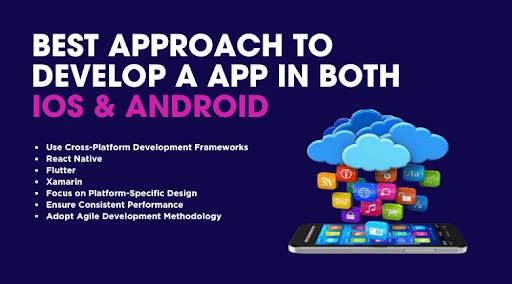Society cannot function without mobile applications, making the need for new solutions for iOS and Android devices essential. This blog covers the fundamentals of mobile application development for both platforms, with a focus on best practices and trends. Understanding the implications of the differences is crucial, whether you are a newcomer to the development industry or an experienced developer. Grasping these concepts is vital to creating successful applications. A common question is, “Can you develop an app for both iOS and Android?” The answer is choosing the right approach and tools to effectively meet the needs of both platforms.
Key Difference Between iOS and Android App Development
1. Programming Languages:
iOS: Mainly using Swift and Objective-C, although Swift is a relatively new type of code it is better than Objective-C because of the better syntax and added security measures.
Android: Mainly works with Java and Kotlin. Kotlin is gradually gaining popularity due to the above characteristics, namely, Kotlin is concise and interoperable with Java.
2. Development Environment
iOS: Coding and development are accomplished in Xcode – the IDE provided by Apple for developing application software.
Android: Includes Android Studio, the official IDE; it contains a lot of resources with regard to testing and debugging.
3. User Interface Guidelines
iOS: Disregards Apple’s Human Interface Guidelines by not encompassing simplicity and easy-to-navigate spaces.
Android: Follows Material Design, which is based on the idea of depth and layers, which results in even brighter and more varied UI objects.
4. Market Distribution
iOS: Applications are delivered through the Apple App Store and this is more demand for strict authorization of certain applications, known as quality applications.
Android: Main app downloads and installations occur through the Google Play Store, through which apps can be approved faster, but in terms of app quality, the range is much larger.
5. Monetization Models
iOS: Tends to see higher revenues per user than Android and focuses on paid applications and downloadable applications.
Android: Pertains to ad-based monetization and freemium options all the time due to a larger audience and diverse income.
6. Fragmentation
iOS: Restricted compatibility results in a more alike development atmosphere and fewer compatibility issues for the used apparatus.
Android: It has been shown that multiple devices and displays increase the level of difficulty in testing and optimization.
7. Updates and Maintenance
iOS: This approach of updating across devices makes its maintenance and even the deployment of new features easier.
Android: Discontinuity in the devices’ versions may cause continuous delays in updates, which may require extra effort from developers.
Challenges of Developing Apps for both iOS and Android
Diverse Development Environments:
- Each platform requires expertise in different tools: Xcode for iOS and Android Studio for Android.
Fragmentation
- They have large numbers of devices, hence they have issues of compatibility, which makes it difficult to test and optimize for.
User Experience Variations
- Different design guidelines mean that one has to mediate between a constant experience on every platform on which the application is to be developed.
Testing Complexity
- Android has many devices and these OS versions require thorough testing, which raises time and cost.
Maintenance and Updates
- Keeping apps updated on both platforms can strain resources due to different release cycles and bugs.
Effective Strategies for Successful Mobile App Development
To create a successful mobile app, define clear objectives, target audience, and key features. Choose a development model native, hybrid, or cross-platform while considering costs, such as, “How much does it cost to create an app for iOS and Android?” Prioritize user experience (UX) through research to ensure your app meets user needs. Focusing on these strategies will help your mobile app development stand out in a competitive market.
Utilize iterative development with at least two prototypes to gather early user feedback, and conduct extensive testing across multiple devices to identify bugs. Plan for scalability to accommodate increased usage and implement security protocols from the design phase, ensuring API connections are encrypted.
Additionally, optimize performance to improve loading times and responsiveness, especially on lower-end devices. Employ analytics to monitor user behavior and adapt based on observed patterns. Finally, maintain post-launch support to gather feedback and introduce new features. A common question developers face is, “Should I learn Swift and Kotlin or Flutter?” The answer depends on your goals; Swift and Kotlin are essential for native development, while Flutter offers cross-platform capabilities.
As mobile technology continues to grow, is there a demand for mobile app developers? The answer is yes, making these skills increasingly valuable in the job market.
Best Approach to Develop an App in both iOS and android
1. Use Cross-Platform Development Frameworks:
If one has to build apps for both platforms, try frameworks that can be used to write once, and deploy twice models such as React Native, Flutter, or Xamarin.
This approach cuts the development span and costs, while the resultant application operates like a native app.
2. React Native
Based on JavaScript and has a vast number of libraries, which makes it liked by developers.
3. Flutter
Supported by Google and developed in Dart, Flutter enables customizable UIs for visually appealing apps. Many ask, “Is Flutter similar to Swift?” Both focus on aesthetics, but Flutter is cross-platform for iOS and Android, while Swift is for iOS only. Another question is, “Which is better, Java or Flutter?” Java is established for Android, but Flutter offers greater flexibility and faster development.
4. Xamarin
Supports C# programming and comes with good compatibility with Microsoft software, appropriate for .NET programmers.
5. Focus on Platform-Specific Design
Tailor the user interface to align with design guidelines for each platform
- iOS Human Interface Guidelines of Apple.
- Be consistent with the Material Design guidelines of Android.
6. Ensure Consistent Performance
For the present, at least, going through intensive testing and optimization in order to minimize the issues of compatibility and stability in different devices and versions of operating systems.
7. Adopt Agile Development Methodology
Depend on cycles for the faster address of user feedback and for quicker delivery of updates and new functionality.
In Short
When launching an application, it’s essential to understand the differences between iPhone and Android development. By using cross-platform frameworks, prioritizing user interface design, and providing ongoing support, developers can meet user needs effectively. A common question is, “Is it easier to make an app for Android or iOS?” Each platform has its challenges, but staying informed and flexible will help developers remain competitive in the dynamic mobile market.




